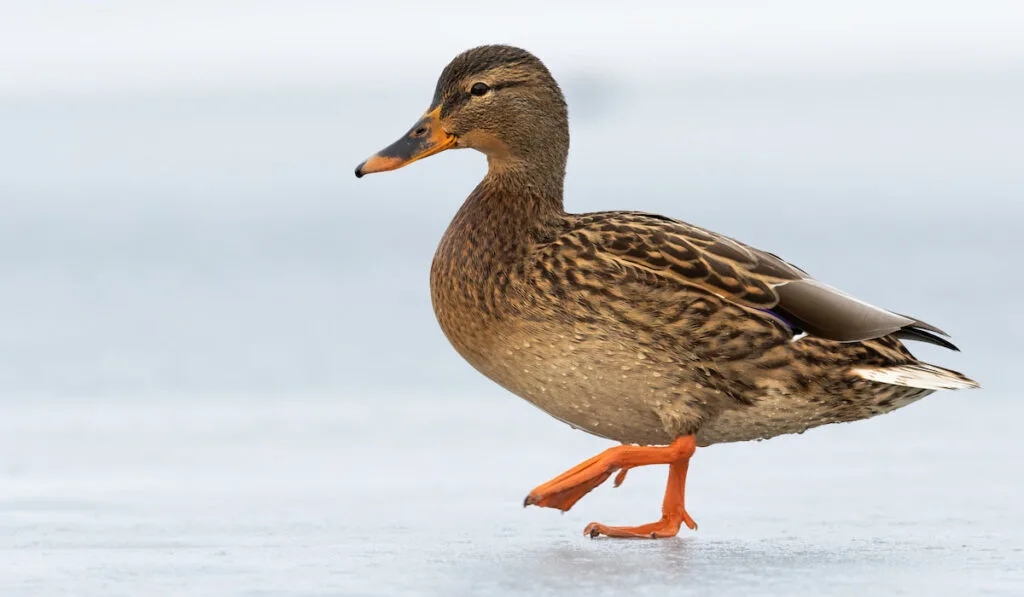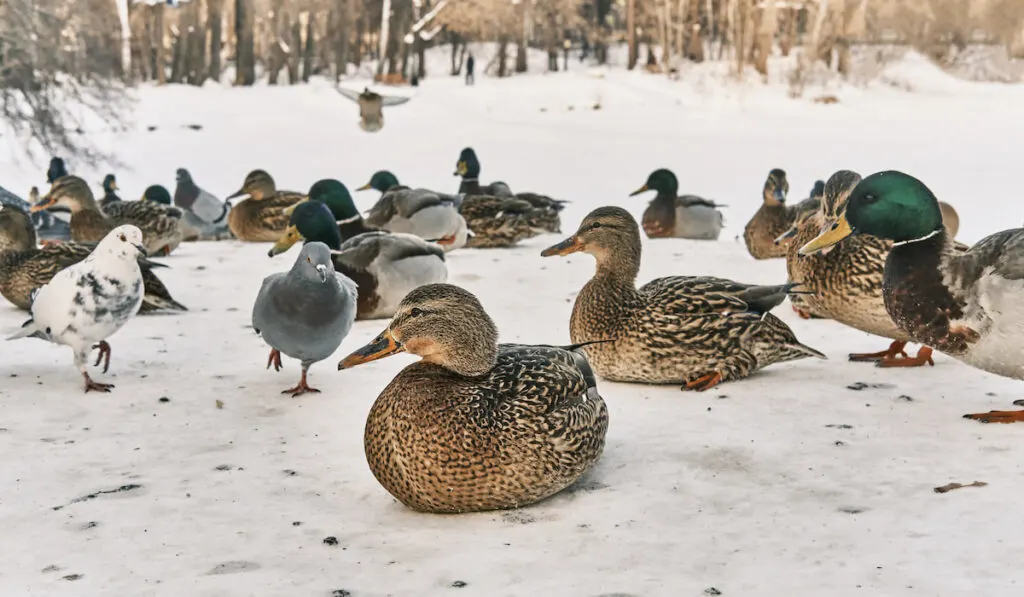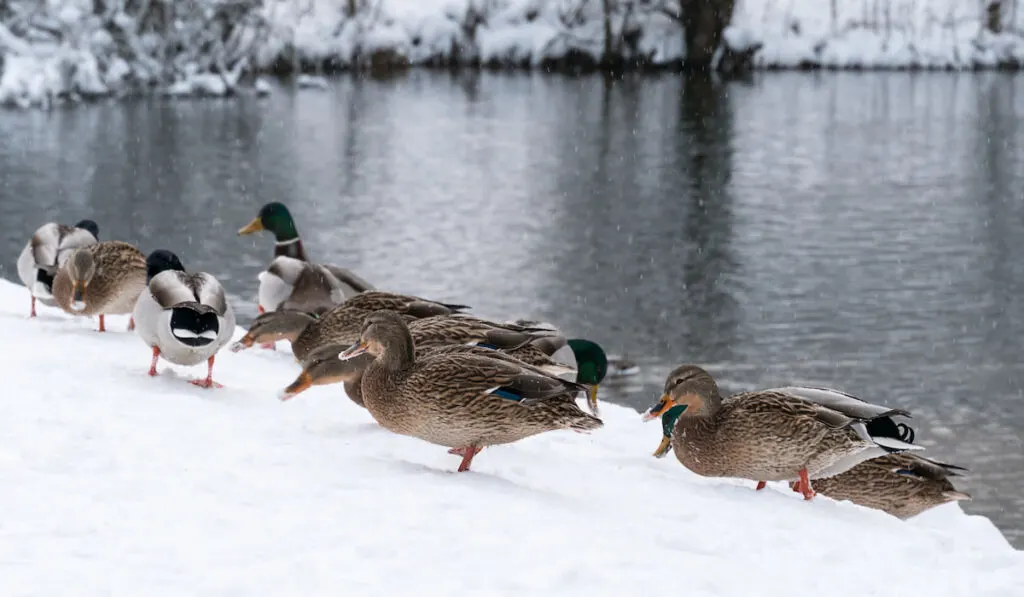Ducks are some of the hardiest birds. They can stay out in the cold and remain unbothered by the harshness of the weather.
Their feathers, fat layers, and preen gland all contribute to ensuring that they can withstand extreme cold.
While ducks are cold hardy, they are not completely immune to the effects of severe cold. Sometimes it gets too cold for them, and when it does, they may show some signs.
When your ducks show signs that they are cold, you have to make provisions to keep them warm immediately. Otherwise, they could become sick.
But what are the signs your ducks will show when they are cold?
Here are seven ways to tell if your duck is cold.
Table of Contents
1. Hobbling on Their Feet
When the temperature falls below 20°F, your duck’s feet may become very cold. When this happens, they react to the extreme temperature by hobbling from one foot to another.
In some cases, rather than hobble, the ducks will stand on one foot while they raise the other toward their belly.
If ducks are left unattended while their feet are cold for prolonged periods of time, they can experience frostbite that can lead to amputation.
To avoid this, you can lay straw, benches, wood shavings, wooden planks, or low stumps in their pen.
Any of these options will insulate their feet from the cold and keep them off the frozen ground.
2. Alternating Between Standing and Plopping
Another way to tell that your ducks are cold is that they will alternate between standing and plopping.
They will stand for a few seconds and then quickly drop down on their bellies to hide their feet under their wings to keep the feet warm.
When they alternate like this, they might find it hard to walk, which is another sign that they are extra cold.
Again, you can lay down insulating bedding in their pen to help keep their feet and bodies off of the cold ground.
3. Black Areas on Their Feet

Ducks can suffer from frostbite if left in extreme cold for a long time. When this happens, you’ll notice black areas on their legs or feet.
If you see these spots, take the duck to a veterinarian for treatment.
Besides treating the affected ducks, you can prevent the others from suffering the same fate by improving ventilation inside their coop.
Ducks give off a lot of moisture when they breathe. If their coop is poorly ventilated, the moisture will make it humid.
Since elevated humidity promotes frostbite, the ducks will be at higher risk of suffering frostbite.
4. Shivering
When your ducks are cold, you might notice them shivering or shaking. If you see this, you should verify that there is no other illness or cause.
Shivering is a non-specific sign, and it could signify an infection or any other disease.
Most times, when a duck starts shivering, you will notice that its plumage is wet.
Under normal circumstances, a duck’s plumage is waterproof and should not become damp. However, this can happen if there’s an issue with the duck’s preen gland.
To prevent this, you could clean your duck’s plumage gently with mild detergent while bathing them in lukewarm water. Doing this will help their feathers recover.
Check out this article for more specific information about why your duck may be shivering.
5. Wet Feathers
Your duck’s feathers might be wet when they are cold. Since duck feathers are waterproof under normal conditions, they are usually well aligned.
But when the feathers become wet, they will appear rumpled or disheveled.
Having wet feathers is usually a sign of excessive preening or an issue with the preen gland.
This may be corrected by cleaning the feathers with a mild soap in warm water. You may also need to call a veterinarian to help treat an infection.
6. Increased Food Consumption

Your ducks may also consume more food when they are cold. Since they need extra energy to keep themselves warm in extreme cold, their bodies burn food faster than usual.
An increased metabolic rate might spur the ducks to consume more food than they usually do.
If the rate at which your ducks consume food increases when they are cold, you can make things easier for them by providing high-energy treats.
These snacks will help them gain weight and provide extra energy to help them stay warm.
Some high-energy treats you can give your ducks include:
- Cracked corn
- Peanuts
- Algae
- Warm oatmeal
7. Motionless
If your duck is motionless in the snow or extreme cold, you should suspect that it may be hypothermic.
Ducks can also float motionless in ponds or behave strangely when suffering from hypothermia.
If you notice any of the signs above, pick the duck up, take it indoors, and place it in a warm area.
Heat towels and get a hairdryer with a low-heat setting. Warm the duck by alternating between covering it with a warm towel and heating it with the hairdryer.
When using the hairdryer, focus more on the duck’s chest and wings since their main blood flow is in these areas.
Be patient with the process. Try not to heat the bird up too quickly, or it could die of shock.

Other Things You Can Do for a Cold Duck
You can also consider providing the following to help your ducks stay warm:
- Provide a windbreak to block out the cold winter wind.
- Provide clean drinking water to them in a heated dog water bowl to ensure that it does not freeze.
Final Thoughts
Without a doubt, ducks are very hardy. But you should always keep in mind that they are not invincible to cold.
When the cold seasons come, create an environment that will keep them warm. Besides that, monitor them routinely to ensure that they are still okay and watch for signs that the cold is negatively affecting them.
Resources
- https://www.hgtv.com/outdoors/gardens/animals-and-wildlife/how-to-keep-ducks-warm-in-cool-weather
- https://www.backyardchickens.com/threads/how-can-you-tell-when-ducks-are-cold.936839/
- http://www.majesticwaterfowl.org/mmissue26
- https://www.cuteness.com/article/tell-have-sick-duck
- https://pethelpful.com/farm-pets/top-10-duck-snacks
- http://www.pocketfarm.co.uk/hypothermia-and-frostbite-in-chickens-and-ducks/
